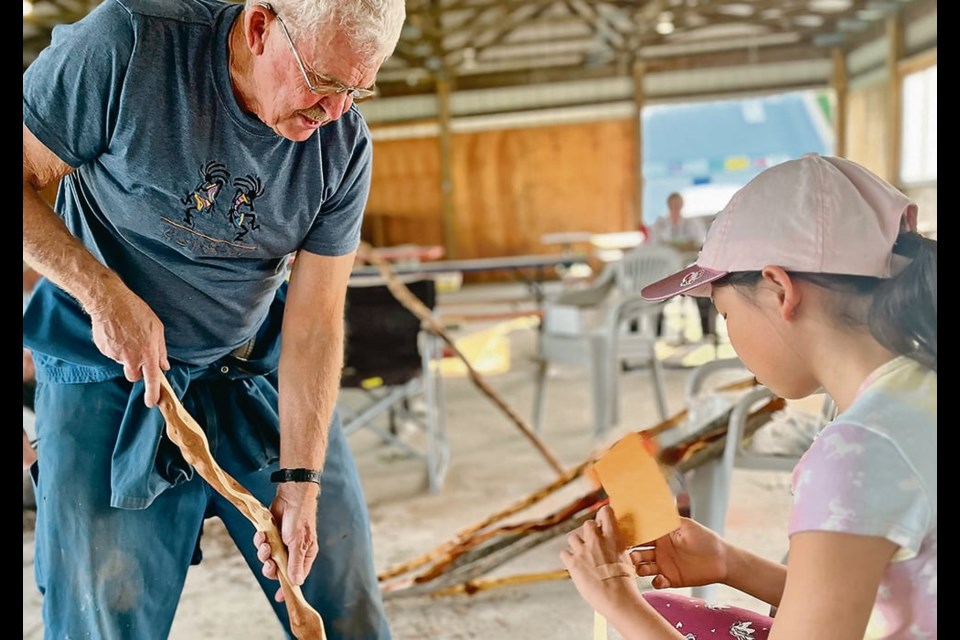MONTMARTRE, Sask. — A retired Saskatchewan social worker not only transforms the wood into art but also enjoys sharing his craft with others
“Now this is the very best part,” he says excitedly as he holds an old sock in his hand.
His 12 students are silent and focused as Greg Mallett runs a white sock dipped in linseed oil along a smoothly sanded willow stick, revealing colours only Mother Nature could create.
“Just look at those blacks in there, and the rich patterns that are coming out,” says the 71-year-old retired social worker, who is delivering a diamond willow walking stick class to students at the Centre 48 arts and education centre in Montmartre, Sask.
Mallett says he never tires of the final step in the laborious process of walking stick making. While removing the bark and sanding the tough willow branch until smooth can take hours, he says the finishing oil coat always delivers a spectacular reward.
“Sometimes I have even called my wife downstairs when I put the oil onto a sanded and finished stick because it’s so amazing to see it pop and suddenly all the work you’ve been doing comes to life and it’s like, ‘wow.’ ”
The wow moments for Mallett have been many over the last 12 years. Not only has he made hundreds of walking sticks, but he has also taught hundreds how to make their own sticks in classes offered throughout southern Saskatchewan.
On this night, a dozen eager learners aged 12 to 80 are gathered to absorb all the knowledge that Mallett has garnered over his lifetime as a nature enthusiast. Having grown up on an acreage in Lloydminster, Sask., Mallett spent hours in the bush.
“I was that kid that was always coming home with a baby rabbit or something like that, and my mom would say, ‘take it back to the bush right now,’” says the Pilot Butte, Sask., resident.
His love of the outdoors also crept into his 37-year career as a social worker in Regina when he worked in youth care.
“I always used the outdoors with my kids, whether I took them cross-country skiing or taught them to make a fire in the bush or took them up north.”
When the outdoorsman retired in 2011, the call of the wild led him straight back to a willow bush. He now scours Saskatchewan’s landscape for rare pieces of willow that make strong, straight and patterned sticks. He most often finds these “diamonds in the rough” near marshy areas or in former marshes that have dried up.
The key is finding wood that is 15 to 25 years old that has been attacked by fungus because the fungus growing where the side branches attach to the main willow stick creates the patterning.
“If I see a branch where there are two or three diamonds, I’ll walk right by until I come across a piece that has diamonds every few inches,” says Mallett. “I then look for how straight the piece is, what the diameter is and how it feels in the hand.”
The first step at tonight’s class is to have his students pick out an aged piece of willow that Mallett has cut eight months to two years earlier. He coaches his students through three hours of bark peeling, stick sanding and diamond dremeling.
Tonight, 12-year-old Tytan Romanow from Corning, Sask., has come to the class with his mom, Natasha Romanow. The pair work beside one another, using great effort to strip the bark off their sticks and smooth them with precision.
In a quiet moment, Tytan asks the retired social worker about the knives he uses on the bark, which leads to the story of a knife Mallett received from his father when he was nine years old. As the instructor proudly displays his bone-handled knife, he and Tytan grin widely, knowing the significance of both a 60-year-old knife and this special moment of connection.
“I loved seeing Tytan being so involved in the class,” says Natasha. “It is hard sometimes to find things to do that we both enjoy, so this ended up being a great night out where we both had fun and learned some new skills that we can use to do it again at home later on.”
For Mallett, any class that ends in wow-factor diamonds on well-sanded walking sticks is a triumph.
“What I enjoy the most is seeing the enthusiasm of people and the sense of satisfaction they get from finishing a stick,” says Mallett.




